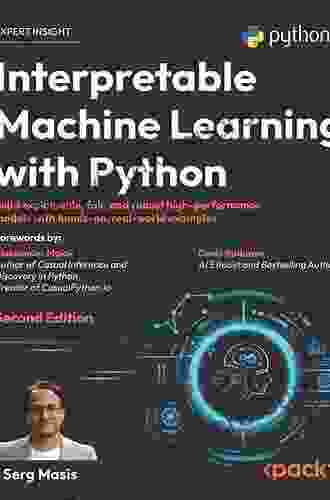Unlocking the Power of Explainable Artificial Intelligence: A Comprehensive Guide to Interpretable Machine Learning With Python

In the realm of artificial intelligence (AI),machine learning algorithms have become indispensable tools for extracting insights from vast amounts of data. However, as these algorithms grow increasingly complex, understanding how they arrive at their predictions becomes crucial. Interpretable machine learning addresses this challenge by providing techniques that unveil the inner workings of AI models, transforming them from black boxes into transparent explanations.
4.6 out of 5
| Language | : | English |
| File size | : | 23465 KB |
| Text-to-Speech | : | Enabled |
| Screen Reader | : | Supported |
| Enhanced typesetting | : | Enabled |
| Print length | : | 736 pages |
Why Interpretability Matters
Interpretability empowers various stakeholders in the AI development process:
- Developers and Data Scientists: Debug and improve models, identify biases, and gain deeper understanding of algorithm behavior.
- Business Users and Decision-Makers: Understand the rationale behind model predictions, enabling informed decision-making and trust in AI systems.
- Regulators and Compliance Officers: Ensure compliance with regulations requiring transparency and explainability in AI systems.
Interpretable Machine Learning Techniques
A diverse range of techniques contribute to interpretable machine learning:
1. Decision Trees
Decision trees are intuitive models that represent decisions as a series of if-else rules. Each node in the tree represents a feature, while the branches represent the decision made based on that feature. Decision trees provide a hierarchical visualization of the model's decision-making process.
2. Feature Importance
Feature importance measures the impact of each feature on the model's predictions. Techniques like Gini importance and permutation importance quantify the contribution of individual features, aiding in understanding which factors drive model outcomes.
3. Partial Dependence Plots
Partial dependence plots visualize the relationship between a target variable and a specific feature, while averaging out the effects of other features. They help identify non-linear relationships and interactions between features.
4. Shapley Values
Shapley values distribute the prediction of a model fairly among its input features. They provide a comprehensive assessment of feature importance, accounting for feature interactions and non-linearities.
5. Local Interpretable Model-Agnostic Explanations (LIME)
LIME is a model-agnostic technique that locally approximates any black-box model. It generates interpretable explanations for individual predictions by fitting a simple, interpretable model to the neighborhood of the data point being explained.
Python Libraries for Interpretable Machine Learning
Python's vibrant ecosystem offers robust libraries for interpretable machine learning:
- SHAP: A versatile library for calculating and visualizing Shapley values.
- LIME: A powerful framework for generating local interpretable explanations for machine learning models.
- ELI5: A user-friendly library that simplifies the explanation of complex machine learning concepts.
- Imblearn: A comprehensive library for handling imbalanced datasets, including techniques for interpretability.
Real-World Applications
Interpretable machine learning finds applications in various domains, including:
- Healthcare: Explaining patient risk predictions and treatment recommendations.
- Finance: Understanding loan approval decisions and identifying factors influencing credit scores.
- Manufacturing: Optimizing production processes by interpreting the impact of variables on product quality.
- Transportation: Analyzing ride-sharing data to improve route planning and predict demand.
Case Study: Interpreting a Random Forest Model
Consider a random forest model for predicting house prices. Using the SHAP library, we can calculate Shapley values to assess feature importance:
python import shap import pandas as pd
# Load data df = pd.read_csv('house_prices.csv')
# Train random forest model model = RandomForestClassifier() model.fit(df.drop('price', axis=1),df['price'])
# Calculate Shapley values explainer = shap.TreeExplainer(model) shapley_values = explainer.shap_values(df.drop('price', axis=1))
# Plot feature importance shap.plots.bar(shapley_values)
The resulting bar plot reveals that the most influential features are 'square_feet', 'num_bedrooms', and 'num_bathrooms'. This interpretation aids in understanding the factors that drive house prices and enables informed decision-making.
Best Practices for Interpretability
To enhance interpretability in machine learning projects:
- Select interpretable models: Opt for models like decision trees or linear regression, which offer inherent interpretability.
- Use interpretability techniques: Leverage the techniques discussed here to make black-box models more transparent.
- Communicate findings effectively: Tailor explanations to the audience's level of technical expertise, using visualizations and plain language.
- Consider ethical implications: Be mindful of the potential biases and unintended consequences of interpretable AI systems.
Interpretable machine learning is a transformative approach that empowers us to unravel the complexities of AI models. By employing a range of techniques and leveraging Python libraries, we can gain valuable insights into how models make predictions. This understanding fosters trust, enables informed decision-making, and unlocks the full potential of AI in various real-world applications. As the field of AI continues to evolve, interpretability will become increasingly essential for responsible and ethical development and deployment of AI systems.
4.6 out of 5
| Language | : | English |
| File size | : | 23465 KB |
| Text-to-Speech | : | Enabled |
| Screen Reader | : | Supported |
| Enhanced typesetting | : | Enabled |
| Print length | : | 736 pages |
Do you want to contribute by writing guest posts on this blog?
Please contact us and send us a resume of previous articles that you have written.
 Fiction
Fiction Non Fiction
Non Fiction Romance
Romance Mystery
Mystery Thriller
Thriller SciFi
SciFi Fantasy
Fantasy Horror
Horror Biography
Biography Selfhelp
Selfhelp Business
Business History
History Classics
Classics Poetry
Poetry Childrens
Childrens Young Adult
Young Adult Educational
Educational Cooking
Cooking Travel
Travel Lifestyle
Lifestyle Spirituality
Spirituality Health
Health Fitness
Fitness Technology
Technology Science
Science Arts
Arts Crafts
Crafts DIY
DIY Gardening
Gardening Petcare
Petcare Topher Donahue
Topher Donahue Rob Fisher
Rob Fisher Susan White
Susan White Brian Pace
Brian Pace Theresa I Soto
Theresa I Soto Sandra T Barnes
Sandra T Barnes Joseph Wayne Smith
Joseph Wayne Smith Kyle Hunt
Kyle Hunt John Bingham
John Bingham Liz Fosslien
Liz Fosslien Erik Qualman
Erik Qualman David Yoon
David Yoon Tom Taulli
Tom Taulli Brendan Leonard
Brendan Leonard Anna B Doe
Anna B Doe Ellie Wood
Ellie Wood Kristine Kathryn Rusch
Kristine Kathryn Rusch Gal Dem
Gal Dem Martin Williams
Martin Williams Amara Charles
Amara Charles Ken Chaddock
Ken Chaddock Sarah Woodbury
Sarah Woodbury Michelle Newhart
Michelle Newhart Theodore Sider
Theodore Sider Brian Klaas
Brian Klaas Victor J Stenger
Victor J Stenger Paul Schwartz
Paul Schwartz Adam Cort
Adam Cort Jameson M Wetmore
Jameson M Wetmore Ruth Nestvold
Ruth Nestvold Arlene Blum
Arlene Blum Derrick Jensen
Derrick Jensen Dana Obleman
Dana Obleman Frederick Lenz
Frederick Lenz Gina Chen
Gina Chen Eric Tyndall
Eric Tyndall Steve Greenberg
Steve Greenberg Amber Foster
Amber Foster Jacob Bronowski
Jacob Bronowski Cole Hersowitz
Cole Hersowitz P Aarne Vesilind
P Aarne Vesilind Michael Abayomi
Michael Abayomi Naomi Oreskes
Naomi Oreskes William Rosen
William Rosen Amie Lands
Amie Lands Neville Goddard
Neville Goddard Robert W D Ball
Robert W D Ball C W Lockhart
C W Lockhart Kathleen Glasgow
Kathleen Glasgow Maria Youtman
Maria Youtman Ned Vizzini
Ned Vizzini Craig Larman
Craig Larman Heidi J Larson
Heidi J Larson Nicholas A Christakis
Nicholas A Christakis Christina Kamp
Christina Kamp Victoria Wood
Victoria Wood Sterling Test Prep
Sterling Test Prep Silvia Botros
Silvia Botros Gary Wiener
Gary Wiener Diane Greer
Diane Greer Tamora Pierce
Tamora Pierce Dmv Test Bank
Dmv Test Bank American Math Academy
American Math Academy Julie Barlow
Julie Barlow Cheri Rae
Cheri Rae Lars Andersen
Lars Andersen Amber Zygutis
Amber Zygutis Joseph P Weir
Joseph P Weir Jonathan Law
Jonathan Law Kate Parham Kordsmeier
Kate Parham Kordsmeier Henry A Zumbrun 2
Henry A Zumbrun 2 Louise Bates Ames
Louise Bates Ames Shannon O Bourne
Shannon O Bourne K F Breene
K F Breene Jennifer Margulis
Jennifer Margulis Bill Carter
Bill Carter Bridget Ericsson
Bridget Ericsson Steven C Hayes
Steven C Hayes Doug Peterson
Doug Peterson Larry K Brendtro
Larry K Brendtro Patricia L Papernow
Patricia L Papernow Jeffrey Steadman
Jeffrey Steadman Christine Fanthome
Christine Fanthome Tabitha Suzuma
Tabitha Suzuma Anthony Horowitz
Anthony Horowitz Temple Grandin
Temple Grandin Tom Deck
Tom Deck John Lukacs
John Lukacs Donovan Hohn
Donovan Hohn Marco Ferrero
Marco Ferrero Tom Colicchio
Tom Colicchio Jake Maddox
Jake Maddox Paul Graham
Paul Graham Don Orwell
Don Orwell Tanya Turner
Tanya Turner Jack Nisbet
Jack Nisbet Jd Mader
Jd Mader Ruta Nonacs
Ruta Nonacs Sheri Van Dijk
Sheri Van Dijk Gia Giasullo
Gia Giasullo Jean Van T Hul
Jean Van T Hul Ruth M Tappen
Ruth M Tappen Elizabeth S Gilbert
Elizabeth S Gilbert Nina Freudenberger
Nina Freudenberger Dr Bob Rotella
Dr Bob Rotella Randall E Schumacker
Randall E Schumacker Ned Seaton
Ned Seaton Test Masters
Test Masters Hadley Wickham
Hadley Wickham Lizabeth Hardman
Lizabeth Hardman Jeremy J Baumberg
Jeremy J Baumberg Nikhil Bhardwaj
Nikhil Bhardwaj Charles Hall
Charles Hall Joe Dan Lowry
Joe Dan Lowry C L Simchick
C L Simchick Cathy Williams
Cathy Williams Erika Napoletano
Erika Napoletano Md Mahady Hasan
Md Mahady Hasan Andy Couturier
Andy Couturier Spike Dykes
Spike Dykes Kresley Cole
Kresley Cole Don Stradley
Don Stradley Stephen Barr
Stephen Barr Anne Chambers
Anne Chambers Pico Iyer
Pico Iyer Patrick O Sullivan
Patrick O Sullivan Wolf Moon
Wolf Moon Zeshan Qureshi
Zeshan Qureshi Brittany Clair
Brittany Clair Norman Doidge
Norman Doidge Jack Tupp
Jack Tupp Rachel Gurevich
Rachel Gurevich Michaela Riva Gaaserud
Michaela Riva Gaaserud Sharon K Zumbrunn
Sharon K Zumbrunn Chad Starkey
Chad Starkey Jeanne Ryan
Jeanne Ryan Cordelia K Castel
Cordelia K Castel Amit Saha
Amit Saha Elise Christie
Elise Christie Nicholeen Peck
Nicholeen Peck Warren B Powell
Warren B Powell Fred Pyrczak
Fred Pyrczak Marshall Goldsmith
Marshall Goldsmith E T Bryant
E T Bryant Donna Williams
Donna Williams Edward J Denecke
Edward J Denecke George Bernard Shaw
George Bernard Shaw Amy Mccready
Amy Mccready Lisa Zimmer Hatch
Lisa Zimmer Hatch Jan Marie Mueller
Jan Marie Mueller Joseph Mcmoneagle
Joseph Mcmoneagle Karen Deerwester
Karen Deerwester Tahlia Kirk
Tahlia Kirk Jan E Stets
Jan E Stets John Mcpherson
John Mcpherson Sean Gibson
Sean Gibson Amy Bleuel
Amy Bleuel Jean Rose
Jean Rose Art Star
Art Star Devin Olsen
Devin Olsen Denise Ni
Denise Ni Erin Chack
Erin Chack Philippa Langley
Philippa Langley Iain Pardoe
Iain Pardoe Claudia J Carr
Claudia J Carr Nisha Garg
Nisha Garg Eugene C Toy
Eugene C Toy Josiah Hesse
Josiah Hesse David Grinspoon
David Grinspoon Django Paris
Django Paris Jennifer S Kelly
Jennifer S Kelly Jessica Hatcher Moore
Jessica Hatcher Moore Andy Hunt
Andy Hunt Pav Bryan
Pav Bryan Jean Christie Ashmore
Jean Christie Ashmore Terry Wieland
Terry Wieland Cody Monk
Cody Monk James P Kelly
James P Kelly Julie Caplin
Julie Caplin Amy Bizzarri
Amy Bizzarri June Cl Tan
June Cl Tan Mariano Anaya
Mariano Anaya Kris Leonard
Kris Leonard Amber Lee Sellers
Amber Lee Sellers Dr Elizabeth Cherevaty Nd Rac
Dr Elizabeth Cherevaty Nd Rac Rick Stanton
Rick Stanton Gerald Corey
Gerald Corey John Jacobs
John Jacobs William Stillman
William Stillman Melody Schreiber
Melody Schreiber Desi Northup
Desi Northup David Salsburg
David Salsburg J Stephen Jones
J Stephen Jones Ronda Rousey
Ronda Rousey Kathleen M Stacy
Kathleen M Stacy Kate Fox
Kate Fox Ray Mancini
Ray Mancini Peter Hayes
Peter Hayes Amy Adele Hasinoff
Amy Adele Hasinoff Reinhold Messner
Reinhold Messner James Mullaney
James Mullaney Md Rezowan Ahmed
Md Rezowan Ahmed Stephen Walker
Stephen Walker Peter Larson
Peter Larson Jonathon Miller Weisberger
Jonathon Miller Weisberger American Psychological Association
American Psychological Association Elizabeth Lim
Elizabeth Lim Andy Singleton
Andy Singleton Janet Engle
Janet Engle Amie Kaufman
Amie Kaufman Jason Borte
Jason Borte Amber O Neal Johnston
Amber O Neal Johnston Krystal Sutherland
Krystal Sutherland Amante P Marinas
Amante P Marinas Matthew L Martin
Matthew L Martin Julie Mosier
Julie Mosier Richard Cohen
Richard Cohen Dom Amore
Dom Amore Rick Deutsch
Rick Deutsch Dima Zales
Dima Zales Tijan
Tijan Marisa Anne Bass
Marisa Anne Bass Alex Polyakov
Alex Polyakov Amby Cooper
Amby Cooper Kezia Endsley
Kezia Endsley Amy Brown
Amy Brown William Glasser M D
William Glasser M D Mark Taylor
Mark Taylor Sheena Johnstone
Sheena Johnstone Muhammad Vandestra
Muhammad Vandestra Tavi Gevinson
Tavi Gevinson Jack Freeman
Jack Freeman Shere Hite
Shere Hite Alan Margot
Alan Margot Marit Weisenberg
Marit Weisenberg Douglas Wilson
Douglas Wilson H Bedford Jones
H Bedford Jones Paul Wieland
Paul Wieland Mark Turley
Mark Turley Jenni Hicks
Jenni Hicks Sian Warriner
Sian Warriner Alan I Marcus
Alan I Marcus Thom Hartmann
Thom Hartmann Glenn Stout
Glenn Stout Erica T Lehrer
Erica T Lehrer Amy B Middleman
Amy B Middleman Tracy Lorraine
Tracy Lorraine Therese A Rando
Therese A Rando Robert A Weinberg
Robert A Weinberg Sean Go
Sean Go Garrett M Fitzmaurice
Garrett M Fitzmaurice American Baseball Coaches Association
American Baseball Coaches Association Chris Irons
Chris Irons Stephenie Meyer
Stephenie Meyer Torey L Hayden
Torey L Hayden Robyn Davidson
Robyn Davidson Don Mann
Don Mann Stanley J Farlow
Stanley J Farlow Wendy Margolis
Wendy Margolis Joseph Howse
Joseph Howse Guillaume Haeringer
Guillaume Haeringer Pamela Lynn
Pamela Lynn Martin Pollizotto
Martin Pollizotto Sonia Hartl
Sonia Hartl Amelia Freer
Amelia Freer Michael Ondaatje
Michael Ondaatje Deborah Vinall Psyd Lmft
Deborah Vinall Psyd Lmft Paul Oliver
Paul Oliver Holly Herrick
Holly Herrick Ignatius Donnelly
Ignatius Donnelly Rich Rousseau
Rich Rousseau Autumn Jordon
Autumn Jordon Amber Lia
Amber Lia Amber Smith
Amber Smith Sue Monk Kidd
Sue Monk Kidd Robb Walsh
Robb Walsh Susanna Heli
Susanna Heli Christopher Cousteau
Christopher Cousteau Howard J Meditz
Howard J Meditz Sarah Sumbal
Sarah Sumbal Oscar Baechler
Oscar Baechler Charles J Alsheimer
Charles J Alsheimer Leslie Sansone
Leslie Sansone Jeff Gaudette
Jeff Gaudette Dan Schlossberg
Dan Schlossberg Joseph Conrad
Joseph Conrad Tom Patri
Tom Patri Eugenia Viti
Eugenia Viti Alex Stone
Alex Stone Emma Mae Jenkins
Emma Mae Jenkins Paul Dickson
Paul Dickson James E Packer
James E Packer Steven Charleston
Steven Charleston Andrey Ryanskiy
Andrey Ryanskiy Richard Wagamese
Richard Wagamese Summer Michaud Skog
Summer Michaud Skog Jessica Cunsolo
Jessica Cunsolo Michael Reichert
Michael Reichert Courtney Defeo
Courtney Defeo Deborah Lipsky
Deborah Lipsky Kasie West
Kasie West Eric T Knight
Eric T Knight Clancy Cavnar
Clancy Cavnar Lisa Maloney
Lisa Maloney Vince Kotchian
Vince Kotchian Catherine Ryan Gregory
Catherine Ryan Gregory Redmond O Hanlon
Redmond O Hanlon Bruce Dowbiggin
Bruce Dowbiggin Philip Gibson
Philip Gibson Timothy Malcolm
Timothy Malcolm Trevor Day
Trevor Day Amir Alexander
Amir Alexander Shalabh Aggarwal
Shalabh Aggarwal Malba Tahan
Malba Tahan Chloe Gong
Chloe Gong Harley Reid
Harley Reid Thomas J Whalen
Thomas J Whalen Lady Antiva
Lady Antiva Kate Tietje
Kate Tietje Paul Kockelman
Paul Kockelman Kumo Kagyu
Kumo Kagyu Sarah J Maas
Sarah J Maas Sandra Luna Mccune
Sandra Luna Mccune Jocelyn Goodwin
Jocelyn Goodwin Nikala Smith
Nikala Smith Sarah Morgan Haydock
Sarah Morgan Haydock Ananda Lowe
Ananda Lowe Benjamin Jelen
Benjamin Jelen Theresa Y Wee M D
Theresa Y Wee M D Vicki Hearne
Vicki Hearne Shanna Cunning
Shanna Cunning Amelia Parker
Amelia Parker Roman Gelperin
Roman Gelperin Rodney M Howard Browne
Rodney M Howard Browne Jim Santos
Jim Santos Matthew Lombardi
Matthew Lombardi Jenny Landreth
Jenny Landreth Joan Freeman
Joan Freeman Gail Maccoll
Gail Maccoll John Maxwell Wood
John Maxwell Wood Camille Glenn
Camille Glenn Pinky Mckay
Pinky Mckay Mark W T Harvey
Mark W T Harvey Kieron Gillen
Kieron Gillen Buck Tilton
Buck Tilton Laura Slinn
Laura Slinn Eric E Bowne
Eric E Bowne Paul Kaplowitz
Paul Kaplowitz Dr Scott A Johnson
Dr Scott A Johnson Josephine Atluri
Josephine Atluri Amira Mikhail
Amira Mikhail Ryan Gray
Ryan Gray L Frank Baum
L Frank Baum Amy Blakeslee
Amy Blakeslee Carlo Buzzichelli
Carlo Buzzichelli Eric Zweig
Eric Zweig Deborah J Rumsey
Deborah J Rumsey Stephen J Collier
Stephen J Collier Stephen M Barr
Stephen M Barr Isabella Krystynek
Isabella Krystynek Laurie A Watkins
Laurie A Watkins J L Weil
J L Weil Dolores Kong
Dolores Kong Tyler Simmons
Tyler Simmons Brian Kateman
Brian Kateman J Marin Younker
J Marin Younker Vivian Vande Velde
Vivian Vande Velde Joe Dante
Joe Dante Joellen Patterson
Joellen Patterson Ashley Scott
Ashley Scott Mitt Romney
Mitt Romney Jason Thompson
Jason Thompson Michael Winkelman
Michael Winkelman John Ferrell
John Ferrell Christopher Harlan
Christopher Harlan Cynthia Gabriel
Cynthia Gabriel Vinod Kumar Khanna
Vinod Kumar Khanna Jack Falla
Jack Falla Grant Dever
Grant Dever Helena P Blavasky
Helena P Blavasky Amelia Edith Huddleston Barr
Amelia Edith Huddleston Barr Byron Nelson
Byron Nelson Umer W
Umer W Jonathan Bartlett
Jonathan Bartlett David Guymer
David Guymer Sarah Dessen
Sarah Dessen Antonio R Damasio
Antonio R Damasio Victoria Richards
Victoria Richards Amiee Mueller
Amiee Mueller Traci Gormley
Traci Gormley James W Williams
James W Williams Chad Ford
Chad Ford Katherine Kurtz
Katherine Kurtz Jack Ewing
Jack Ewing Rose Mannering
Rose Mannering Mark Worden
Mark Worden Dan Abnett
Dan Abnett Trent Shelton
Trent Shelton Nick Kolenda
Nick Kolenda Joel Cotton
Joel Cotton Kathy Spratt
Kathy Spratt Swede Burns
Swede Burns Sandra Bardwell
Sandra Bardwell Suzanne Stabile
Suzanne Stabile Amy Camp
Amy Camp Helen E Fisher
Helen E Fisher Nathan Belofsky
Nathan Belofsky Mark Stallard
Mark Stallard John A Buehrens
John A Buehrens Jayson Gaddis
Jayson Gaddis Randy Schultz
Randy Schultz Laekan Zea Kemp
Laekan Zea Kemp Dave Hanson
Dave Hanson Frank Nappi
Frank Nappi Joe E Harvey
Joe E Harvey Wade Rouse
Wade Rouse A Sorority Of Mothers
A Sorority Of Mothers Bethanne Kim
Bethanne Kim Derek Thompson
Derek Thompson Jack Weatherford
Jack Weatherford Tim Marshall
Tim Marshall The 60 Minutes Summary
The 60 Minutes Summary Joe Nickell
Joe Nickell Amrita Pande
Amrita Pande Julie Schacht Sway
Julie Schacht Sway Michael Parker Pearson
Michael Parker Pearson Shaun Gallagher
Shaun Gallagher Kevin Stiegelmaier
Kevin Stiegelmaier Joseph Klaits
Joseph KlaitsK D
 Christopher E Larsen
Christopher E Larsen Josh Taylor
Josh Taylor Don Bowers
Don Bowers Charles Thompson
Charles Thompson Chris Carlsson
Chris Carlsson Toni Tone
Toni Tone Kenneth P Stephens
Kenneth P Stephens Amy Baldwin
Amy Baldwin Michael Cosgrove
Michael Cosgrove Kathy A Zahler
Kathy A Zahler Rosanna Davison
Rosanna Davison Mac Fortner
Mac Fortner Danny Dreyer
Danny Dreyer Amy Perry
Amy Perry Rosalind Wiseman
Rosalind Wiseman Jon Bonnell
Jon Bonnell David Elkington
David Elkington William Bohan
William Bohan Jerry D Moore
Jerry D Moore Robert Melillo
Robert Melillo Rob Antoun
Rob Antoun Johan Norberg
Johan Norberg David Burch
David Burch Valerie Bass
Valerie Bass Ana And Jack Hicks
Ana And Jack Hicks David Ranney
David Ranney K M Shea
K M Shea Laini Taylor
Laini Taylor Michael R Poll
Michael R Poll Stanley I Greenspan
Stanley I Greenspan Heather Macfadyen
Heather Macfadyen Marina Robb
Marina Robb Mike Adamick
Mike Adamick Clotaire Rapaille
Clotaire Rapaille John L Field
John L Field Peter Worley
Peter Worley Angela Moore
Angela Moore Alexandrea Weis
Alexandrea Weis Cookie O Gorman
Cookie O Gorman Jeff Martone
Jeff Martone Tim Hornbaker
Tim Hornbaker Saleh Alkhalifa
Saleh Alkhalifa Meikang Qiu
Meikang Qiu Catherine Dees
Catherine Dees Candy Verney
Candy Verney Anthony Haynes
Anthony Haynes Candida Lawrence
Candida Lawrence Stephen Goodwin
Stephen Goodwin William G Dever
William G Dever
Light bulbAdvertise smarter! Our strategic ad space ensures maximum exposure. Reserve your spot today!

 Virginia WoolfUnveiling the Expertise of Taylor Clinical Nursing Skills: A Comprehensive...
Virginia WoolfUnveiling the Expertise of Taylor Clinical Nursing Skills: A Comprehensive...
 Grayson BellMastering the Art of Influence: An In-Depth Guide to Dale Carnegie's Practice...
Grayson BellMastering the Art of Influence: An In-Depth Guide to Dale Carnegie's Practice...
 Elliott CarterUnveiling the Convergence of Modern Physics and Ancient Faith: A Journey of...
Elliott CarterUnveiling the Convergence of Modern Physics and Ancient Faith: A Journey of... Edgar HayesFollow ·18.9k
Edgar HayesFollow ·18.9k Richard SimmonsFollow ·13.6k
Richard SimmonsFollow ·13.6k Charles ReedFollow ·17.3k
Charles ReedFollow ·17.3k Matthew WardFollow ·4.4k
Matthew WardFollow ·4.4k Ivan TurgenevFollow ·4.9k
Ivan TurgenevFollow ·4.9k Emmett MitchellFollow ·14.6k
Emmett MitchellFollow ·14.6k Joshua ReedFollow ·18.4k
Joshua ReedFollow ·18.4k Brady MitchellFollow ·19k
Brady MitchellFollow ·19k

 Ira Cox
Ira CoxUnveiling the Hidden Gem: Moon, Virginia - A Washington...
Nestled within the picturesque...

 Jorge Luis Borges
Jorge Luis BorgesThe Ultimate Survivalist's Medical Guide: A Comprehensive...
In the realm of...

 Henry Green
Henry GreenDavid Douglas: Exploring the Natural History of the...
David Douglas was a...

 Eric Hayes
Eric HayesUnderstanding Citizenship in a Globalized World: A...
Citizenship is a complex and multifaceted...

 Will Ward
Will WardUnveiling Research Real Talk: Navigating the Labyrinth of...
Research, the...
4.6 out of 5
| Language | : | English |
| File size | : | 23465 KB |
| Text-to-Speech | : | Enabled |
| Screen Reader | : | Supported |
| Enhanced typesetting | : | Enabled |
| Print length | : | 736 pages |








